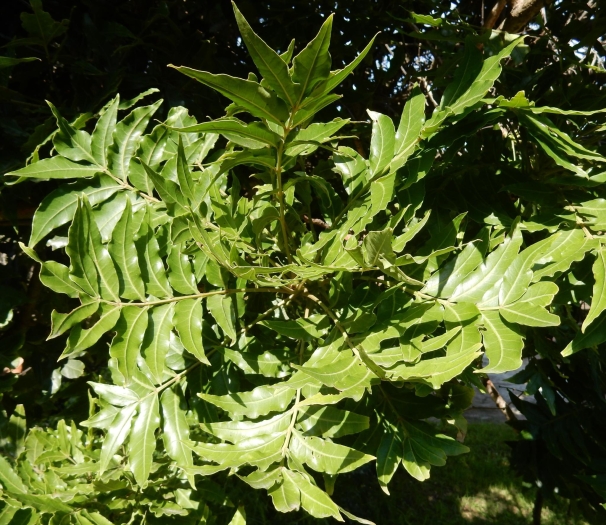Wild Plum
(Harpephyllum caffrum)
Wild Plum (Harpephyllum caffrum)
/
/

Henry de Lange
CC BY 4.0
Image By:
Henry de Lange
Recorded By:
Copyright:
CC BY 4.0
Copyright Notice:
Photo by: Henry de Lange | License Type: CC BY 4.0 | License URL: http://creativecommons.org/licenses/by/4.0/ | Rights Holder: Henry de Lange | Publisher: iNaturalist | Date Created: 2019-05-30T10:04:57Z |

































Estimated Native Range
Summary
Harpephyllum caffrum, commonly known as Wild Plum, is an evergreen tree native to the coastal and riparian forests of Southern Africa, particularly South Africa, Zimbabwe, and Mozambique. It typically grows to a height of 12-45 feet (4-14 meters) and a width of 6-21 feet (1.8-6.4 meters), with a dense, spreading canopy that provides deep shade. The Wild Plum features pinnate leaves that are glossy and dark green, with new growth appearing in a striking reddish hue. During the summer months, it produces inconspicuous white and green flowers, which are followed by attractive, edible red to purple fruit that is favored by birds and humans alike.
The Wild Plum is valued for its drought tolerance and ability to thrive in a variety of soil conditions, making it a versatile choice for gardeners. It is often used in urban landscapes, as a shade tree, and for its edible fruit, which can be eaten fresh or used in preserves. The tree requires full sun for optimal growth and fruit production but can tolerate partial shade. It is relatively low-maintenance, requiring minimal water once established, and prefers soils with good drainage. While generally pest-free, it can occasionally suffer from fruit flies and fungal diseases. The Wild Plum is also known for its non-aggressive root system, making it a safe choice for planting near buildings and hardscapes.CC BY-SA 4.0
The Wild Plum is valued for its drought tolerance and ability to thrive in a variety of soil conditions, making it a versatile choice for gardeners. It is often used in urban landscapes, as a shade tree, and for its edible fruit, which can be eaten fresh or used in preserves. The tree requires full sun for optimal growth and fruit production but can tolerate partial shade. It is relatively low-maintenance, requiring minimal water once established, and prefers soils with good drainage. While generally pest-free, it can occasionally suffer from fruit flies and fungal diseases. The Wild Plum is also known for its non-aggressive root system, making it a safe choice for planting near buildings and hardscapes.CC BY-SA 4.0
Plant Description
- Plant Type: Tree
- Height: 12-45 feet
- Width: 6-21 feet
- Growth Rate: Moderate
- Flower Color: White, Green
- Flowering Season: Summer
- Leaf Retention: Evergreen
Growth Requirements
- Sun: Full Sun
- Water: Medium
- Drainage: Medium, Fast
Common Uses
Bird Garden, Butterfly Garden, Edible*Disclaimer: Easyscape's listed plant edibility is for informational use. Always verify the safety and proper identification of any plant before consumption., Low Maintenance
Natural Habitat
Coastal and riparian forests of Southern Africa
Other Names
Common Names: Kaffir Plum
Scientific Names: , Harpephyllum caffrum, Spondias falcata, Harpephyllum serratum, Odina caffra, Tapirira caffra,
GBIF Accepted Name: Harpephyllum caffrum Bernh.